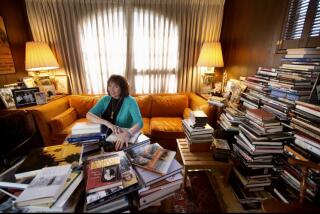Paul McCartney: Here, There and Everywhere
- Share via
Beatles fans have long referred to Paul McCartney as the cute Beatle, but the cyber-Beatle? McCartney made history Saturday, when his Town Hall Meeting in London was broadcast live on VH1, while being Webcast simultaneously to a site set up by E! Online, Sun Microsystems, AudioNet and Graham Technology.
McCartney became the first former Beatle to answer questions from a live audience, postal mail, telephone, e-mail, on-the-street fans and from chat rooms all in a whirlwind hour and a half. The Web site jokingly gave the address of the town hall so fans could try carrier pigeon as well.
The idea was to marry a TV broadcast with a Webcast where fans could ask McCartney questions and chat among themselves. The one-hour TV show included a world premiere video and banter about McCartney’s upcoming album, “Flaming Pie.” Then McCartney went online exclusively, answering more colorful questions from chatters.
“By doing both, we wanted to give the audience the best possible chance of participating in the event,” said Liz Heller, senior vice president of new media at Capitol Records. “We’ve found that people will log on to their computer while watching TV. Combining TV and the Net is where these events are going in the future.”
That synergy might have worked on the East Coast, but Left Coasters were left out because VH1 inexplicably ran the broadcast on a three-hour delay. That meant that by the time many TV viewers saw the “live” meeting, it had closed up shop on the Web. TV promos telling viewers to go online had an added tagline: “West Coast viewers ignore this message.”
Still, the TV broadcast had a loose, hectic feel to it. It took place at London’s Bishopsgate Hall, referred to in “Being for the Benefit of Mr. Kite!” from the Beatles’ “Sgt. Pepper” album. McCartney even held an impromptu sing-along with a ditty he made up in the dressing room about Bishopsgate.
During the telecast, the Web site handled massive amounts of visitors by splitting into four areas: video and chat; audio and chat; video only; and audio only. Plus, when you entered chat rooms, you could choose Java-based chat or non-Java chat, both of which were developed by E! Online. This way, users with higher bandwidth could watch a video feed while chatting, while low-banders could just chat while watching TV.
Those with Java-enabled browsers didn’t have to download special plug-ins for the video feed, thanks to a streaming video technology called JPEG push. The technology, developed by Graham Technology, takes advantage of a “server push” format to eliminate the need for special applications on the user’s end.
Although much of the TV broadcast had an infomercial feel to it, with the audience applauding every mention of world peace or vegetarianism, the online realm was a bit more unusual.
One Beatlemaniac asked the whereabouts of the 27-minute version of the song “Helter Skelter” (McCartney didn’t know), and another asked whether McCartney was wearing boxers or briefs (“I’ll stay enigmatic on that one,” he said, coughing).
During the broadcast, VH1 interviewer John Fugelsang said “we received the largest response in the history of the Internet” by receiving more than 3 million questions. Those superlatives are impressive but difficult to back up. When pressed, Capitol’s Heller said that people could have submitted questions more than once, plus many questions were sent by fans during a contest weeks before the Webcast.
*
Mark Glaser can be reached at McGlaze@aol.com
More to Read
The biggest entertainment stories
Get our big stories about Hollywood, film, television, music, arts, culture and more right in your inbox as soon as they publish.
You may occasionally receive promotional content from the Los Angeles Times.









